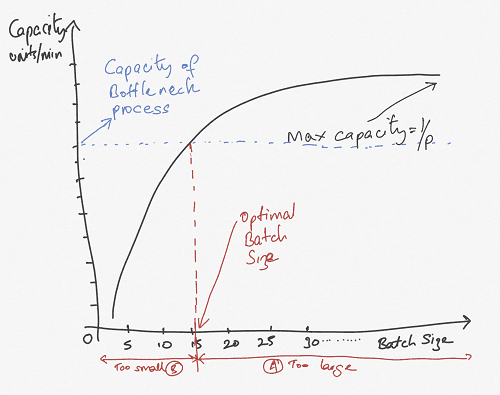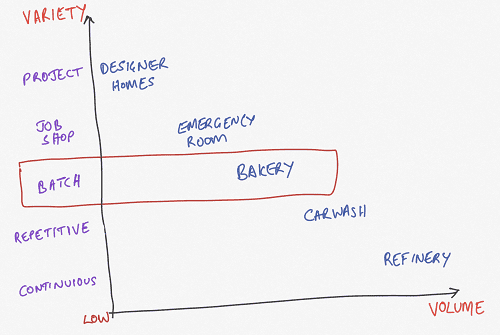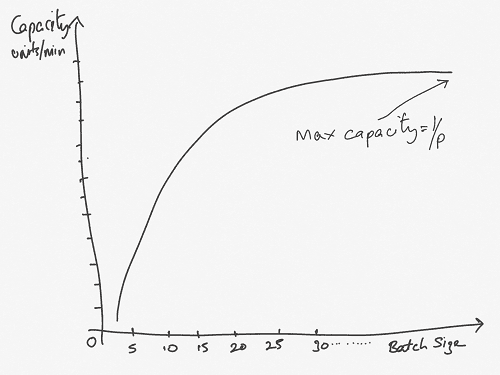Every MBA student encounters operations management in their first year or semester of their MBA programs. In operations management, every production processes is classified into one of five basic process types: projects, job shops, batches, repetitive production, and continuous production. Our graduate level operations research tutors will help you analyze and understand each type of process with one on one tutoring.
Each production process has its advantages and disadvantages, and each one is more suitable or less suitable to different products and services. For example, on one end, you can see a project-based process where every product or unit has different requirements, characteristics, and features. On the other hand, a continuous process produces the same type of unit or product. We deal with batch processing on this page and try to understand the different characteristics and insights when managing a batch process.
Examples of Batch Processes
Batch processing is ideal when a moderate volume of goods or services that are identical or similar is produced. The batch system offers some flexibility in offering too. It can handle a reasonable variety of products, and the equipment need not be as flexible as in a job shop. Products ideally suited to batch processing include bakery items, paint, ice cream, beer, magazines, books, etc. Services ideally suited to batch processing include plays, concerts, musicals, radio, etc.
Key Ingredients to Understand When Managing A Batch Process
Setup Time
Set up time is the time taken to set up a machine, job floor, or table before a batch of production or a task starts or for switching from one product type to another. Setup time is also referred to as change over time.
Some real-world examples of setup time include cleaning the table before the next customer or cleaning the machine before the next production run, positioning tools for a new design or batch, refilling raw materials like baking a set of cookies, etc.
No manufacturing or production takes place during the setup time. So you may think of setup time as non-productive time. However, it is a required part of the production or service process.
A Batch
Batches are the collection of units produced as a group. For example, when baking a set of cookies, the number of cookies put in the oven simultaneously is considered a batch. Units produced in succession may also be considered a batch if it is run continuously for a period before the process stops for a refill or update or input of ingredients. A batch must contain the same type of flow unit.
The impact of setup time and batch production on capacity and inventory.
Capacity given batch size and setup time.
If the operation uses the batch system, the capacity of the system can be computed by dividing the batch size by the total of setup time and time taken to process one batch.
Capacity increases as batch size increases.
From the above formula, you will see that when the batch size increases, the process capacity increases. This is because when batch size increases, setups are less frequent. Similarly, you will notice that if the time per unit decreases, the higher the capacity. Again, this is because as you take less time to produce a unit, you will be able to make more units per unit of time.

Capacity increases as batch size increases but has a LIMIT.
So you might think that you want to make increasingly larger batches to keep increasing capacity. However, it is essential to know that the above rule does not apply uniformly. There are decreasing effects to scale, and there’s a limit on improving the capacity. As the batch size increases, capacity approaches the capacity the process could achieve if setup time becomes zero.
Inventory given batch size?
Another disadvantage of increasing batch size is its impact on inventory. How does the batch size impact inventory? You will notice from the diagram below that as the batch size increases, inventory levels increase. Given this fact, how will you decide on the optimal batch size?
How to choose the optimal “batch size” given a setup time? Matching supply with demand
So we’ve learned that increasing the batch size increases capacity. However, we have also learned that 1) there’s a limit to the capacity increase that can be gained by increasing batch sizes, and 2) increasing batch size increases inventory levels. So, what is the optimal batch size?

An optimal batch size is established by setting the batch size equal to the flow rate and demand.
Capacity = Flow rate = Demand
We can derive the formula for the optimal batch size by rearranging the flow rate formula as indicated below.
Batch Size and Bottlenecks
Not only should we match the optimal capacity to flow rate we must also be aware of bottleneck limitations. Look at the chart below. You must consider the upper limit of the bottleneck when establishing capacity.

Our operations research tutors will help you analyze and understand your all your operations management processes and case studies not just the ones involving batch processes. Other operations research topics we can assist you include optimization using R, queuing theory and waiting lines, decision trees, linear programing using Microsoft Excel’s Solver, newsvendor models, batch processing, Littlefield simulation games. etc.So give yus a call or email us if we can support you with one on one tutoring.

